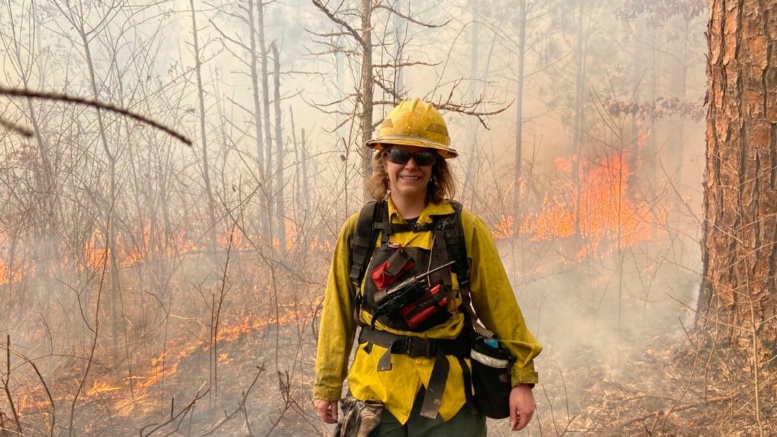By Maggie Beamguard
Insider Editor
When it comes to picking a vocation, some people are drawn to careers in the great indoors. Others seek their calling in the elements of the Great Outdoors. Seven Lakes resident Kimberly Rust chose the latter when she joined the U.S. Forest Service as a firefighter 21 years ago.
When Rust moved to North Carolina from Buffalo with her husband, Jeremy, she brought a degree in forestry from State University of New York (SUNY) but was uncertain how she would put it to use. With a little networking through a new neighbor who had a connection to the U.S. Forest Service, Rust landed an interview with the district ranger.
There were two entry-level firefighter openings. The ranger explained that the job was no piece of cake. “It’s hard,” she remembers him saying, “and you have to do this physical fitness test, and you have to carry all this weight, and you’ve gotta sleep in the dirt and it’s smoky.”
But she was far from deterred by his candidness. It sounded like the perfect job description for Rust, who spent weekends as a child playing on 56 acres of family land in southwestern New York with no electricity or running water to their cabin.
“THIS is gonna be my job!” she said.
And so Rust started at the bottom and built her way up through the U.S. Forest Service, taking classes and pursuing various credentials along the way. Now she serves as the Uwharrie District Timber Program Manager with the service.
“When I first started out, I was in a primary fire position, and so that meant if there was a need, I went,” she said. “I could spend the whole summer out on various fires.”
As her family grew to include sons Henry and Charles, her job responsibilities shifted toward timber management. But she never stopped fighting fires. If she has availability and the qualifications needed for any particular fire, she takes one or two 14-day assignments a year, not including travel time. She was most recently deployed in August to the little town of Agnes in southwest Oregon. Over the years, she has also battled blazes in Montana and California.
Typically East Coast-based firefighters get called out west from mid-July through September when the local resources start to feel strain and fresh firefighters are needed.
When an assignment comes, Rust often gets at most two days’ notice to prepare. She kicks into high gear.
“They make fun of me,” Rust says of her family. “I get out the lined paper and my No. 2 pencil, and I write out everything. Feed the dogs. Practice is on this day. The garbage has to go out on this day.” When she has extra notice, she tries to stock some easy-to-cook groceries and catch up on laundry.
“They do really well,” she says, “but it’s three bachelors and two dogs in my house for 18 days. And it’s functioning, but it’s not necessarily up to mom-level standards.”
The family sacrifices allow Rust to pursue her passion. “I love to do it. It’s a great way to travel and see some pretty remote places,” she said.
“I really like to meet all the people. It’s so energizing to meet new people and to run into old friends.” The forest fire-fighting world is small, she says. While in Oregon, she ran into a friend she hadn’t seen in 15 years who called her out by name.
Rust also loves the opportunity to push herself and to discover her capabilities.
“You’re sleeping on the ground in a tent for 14 days. You’re living outside. You’re working long hours and sometimes night shifts.”
It’s not your typical day job. And it’s not a job without risk.
“It’s a dangerous job, but I feel that we’re adequately trained.”
One of the biggest dangers Rust describes is driving through steep country on smoke-filled, narrow roads crowded with fire engines, water tenders and bulldozers.
Falling trees are another hazard. Root systems get burned out and a tree may look green on top but still be structurally unsound. Rust had a close call two years ago with a live-looking Aspen tree out on a mountain during weather.
“We got caught in a lightning storm. That was probably the scariest situation I’ve been in,” she said. “I have a healthy respect and fear of fire, but I’ve never been in a situation where I drop all my stuff and run.”
In her current position, she manages timber at the Uwharrie National Forest, planning and prepping for timber harvests, calculating timber volume and building contracts that go out for bid. She also participates in prescribed burning and will respond to local wildfires.
“I enjoy being outside. The Uwharrie is beautiful. There is so much variety. You could be by the lake, you could be in the clay soils, you could be in the sand with the pines. Fall is beautiful with the leaf color change.”
Rust also enjoys her coworkers, describing a family setting. She has found camaraderie among her colleagues in the historically male-dominated field, though more women are joining the U.S. Forest Service.
“When you’re out fighting fire, you just have to accept that everybody puts their pants on one leg at a time,” she said. “ I’ve always been treated with the utmost respect amongst all the guys. You’re there working as hard as they are.”
It’s an exciting and fulfilling career for Rust, who feels like she landed in the right place 21 years ago. She sees many opportunities for young people in her field if they are willing to be flexible with their location to get their foot in the door with the U.S. Forest Service.
“With climate change, I think we’re going to see an increase in the frequency and severity of these fires,” she said. “You think about these big fires in California or recently in Hawaii, but the reality is that it could happen here and it could be just as catastrophic.”
She encourages people to be vigilant during dry weather seasons by observing burn bans, keeping defensible space around your home by not having trees or stacks of wood close to the house and keeping pine needles out of gutters.
In the Sandhills, the dry seasons run from around mid-October through December or January and from March to mid-May.
“I love going to work every day,” said Rust, who seems to thrive in the elements of nature even when doing battle with them. Not everyone can make such a claim, but she has found a career that turns her ablaze with enthusiasm.
Contact Maggie Beamguard at maggie@thepilot.com.











